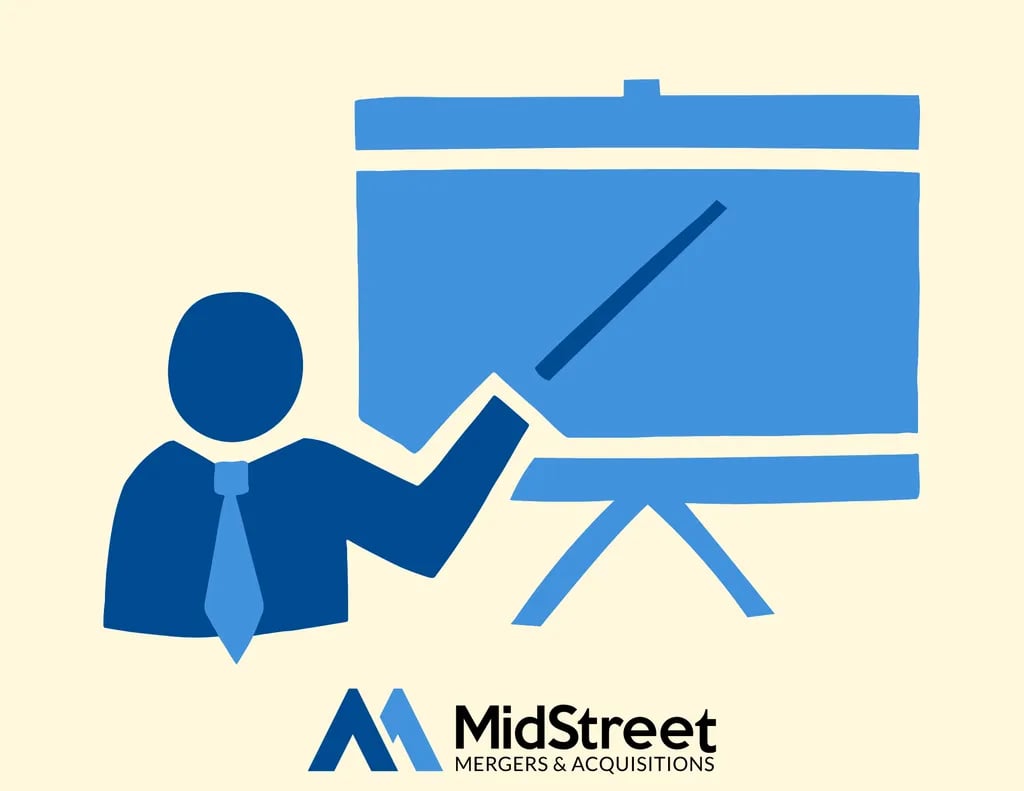Training and Consultation in a Business Sale
If you’ve started the process of selling your business, then your business broker or M&A advisor has probably asked you about your preferences for a training and consultation period.
Even if you haven’t signed a listing agreement yet, you may still be curious about what kind of training you’ll have to provide to the buyer of your business after closing the deal.
The training and consultation period after a business sale is the agreed upon time a seller must remain available either on-site or off-site (sometimes both) to help transition a new owner into the business.
But what exactly does a training and consultation period entail?
How long does it last?
In this blog, we’ll provide answers to each of those questions, give you a clear idea of what to expect when negotiating your training and consultation period, and help you understand why the training terms you agree to are worth serious consideration.
Let’s get started!
Training Terms

Running your business may be second nature to you, but take a moment to consider all the things an outsider would have to learn to step in as a successful owner.
From inventory management systems and operating manuals all the way to company culture, every business has a unique way of operating. So, even if a buyer has extensive experience in your industry or as a business owner, it’s likely they’ll need at least some amount of handholding after closing.
The amount of handholding you’ll do depends entirely on the terms of your training period, which are finalized in the purchase agreement before selling your business.
These terms, including the duration and content of the training period, can vary greatly depending on the needs of your buyer and how extensive a training period you’re willing to provide.
Since different kinds of buyers require different training terms, it’s important to discuss your preferences with your business broker or M&A advisor early in the process of selling.
This can help your intermediary find the right buyer for your business and let potential buyers know up front what kind of training you intend on providing.
For example, if you’re an extremely involved owner of a manufacturing business in the aerospace market, several potential buyers will likely require 150 hours or more of training after closing.
Contrastingly, if you’re a semi-absentee owner of an HVAC service business with efficient systems and personnel in place, your buyer could agree to a training period as short as 50 hours.
Training in this scenario would consist of helping the buyer with onboarding into the systems (QuickBooks, ERP, etc.), transitioning employees, intros to suppliers and larger clients, etc.
Negotiating Training and Consultation Terms
Negotiating the training and consultation terms is something an experienced M&A advisor or business broker can help with. At MidStreet, we like to start laying out these terms in the letter of intent (LOI), but the official language is determined in the purchase agreement.
It’s important to note that you aren't "required" to train a buyer when you sell your business, but keep in mind: if you put too many limitations on your training period, you may not be able to keep as many buyers on the hook.
Most buyers will want access to your knowledge and experience running the business for at least some amount of time after closing.
So, the more restrictive your training terms are, the fewer buyers will feel comfortable transitioning into your company. Limiting buyers in this way will likely have a negative impact on the purchase price you receive for your business.
This isn’t to say you should agree to a yearlong training period when your preference is closer to four months. But if loosening your terms for a training period can get you a higher multiple of earnings for your business, it could be worth considering.
We often suggest that sellers agree to a number of hours within a specified period after closing rather than a number of months.
We’ve seen situations where sellers agreed to six months of training, but by month four, the new owner didn’t need them quite as much as they did in the beginning.
The seller was then coming into the office solely to fulfilling their training requirement even though they weren't always needed.
In this situation, it would have been better for the seller to agree to 100 hours within six months after closing, which would allow them to come in only when they're needed instead of being on-site with nothing to do.
There are several creative ways for buyers and sellers to reach an agreement on the terms of the training period, which is something an experienced M&A advisor or business broker can help facilitate.
Seller Incentives to Train the Buyer
After years of business ownership and a months-long selling process, you may feel reluctant to prolong your involvement in the business with an extensive training period.
Even though this feeling is completely understandable, there are several incentives that may encourage you to properly train the buyer after closing.
Seller Financing
If you sell your business to an individual buyer, there’s always the possibility of you providing seller financing to get the deal done.
When this is the case, it’s imperative you spend considerable time training the buyer. Why?
Individual buyers commonly use an SBA 7(a) loan to purchase businesses. If the business fails, they will be required to pay back the SBA before they pay off the seller note. By the time they pay back the SBA, there may not be enough left to pay back the debt they owe you.
Even if the buyer doesn’t use an SBA 7(a) loan, there’s still the chance they won't be successful in running the business. If they shut down before paying off the seller note, you may never see that money.
In other words, if you offer seller financing, the only way you’ll be reimbursed is if the business does well.
A great way to mitigate this risk is to get your buyer off on the right foot with an extensive training and consultation period.
You Own the Real Estate
There’s also the possibility you or an LLC you manage owns the business’s real estate.
Leasing your real estate to a buyer can be a great source of income for you after a sale, but it can also cause some serious headaches if they’re unable to make their lease payments.
If this were to happen, you wouldn’t want to look back and wonder if you could have prevented the business failing by making sure the new owner was properly trained.
Reputation
We’ve all heard the stories in our communities after a well-known business changes for the worse after being sold.
“They were bought out a few months ago and now things just aren’t the same.”
“Ever since they were bought, they don't have the same level of service.”
“I can’t believe they sold to someone who runs this place so differently.”
The list goes on.
While an M&A advisor can help prevent this by finding a good fit for your business, you can also help maintain your reputation and facilitate a successful acquisition by extensively training the buyer.
Your Employees
As a business owner, the relationships you’ve developed with your staff are hardly something you take for granted.
You’ve likely been a leader, mentor and maybe even a trustworthy friend to several of your employees.
When you exit your business, you want to make sure you’re leaving your them in capable hands.
To make the transition easier for your employees and the new owner, it’s important for you to stick around and foster relationships between the two.
This can help set the business up for success and give your employees peace of mind knowing they can trust the new owner, and vice versa.
Prepare Your Team
The best way to make sure your training period goes smoothly is to prepare yourself and your team for a change in ownership in the months leading up to closing.
NOTE
Preparing your team for a change in ownership doesn't mean you should tell them you're selling. Preparing in this scenario involves delegating responsibilities to your key employees.
One way to do this is to start dialing back your involvement in daily operations.
If your employees and management team can successfully conduct business without your constant supervision or guidance, then you can be confident they’ll do the same with the new owner.
In other words, if your business doesn't rely solely on you to operate, your buyer likely won't need as much training.
Training Structures
Besides the duration of training, there are other items that could be included in the way your training period is structured.
For example, if one or more of your key managers plans on exiting the business with you, the buyer could request training for new management in addition to being trained as the owner.
Training for the new owner and management is allocated in the purchase price of the business. Determining how much of the purchase price should be allocated towards training can be tricky, so you should consult your M&A advisor or CPA once it’s time to negotiate this.
For example, in a recent transaction that sold for $3 million, the allocation in the LOI and purchase agreement was set at $10,000 for 150 hours of training.
Keep in mind, the training portion of the purchase price is taxed at ordinary income rates rather than the favorable capital gains rates, so you generally want to keep the training allocation as low as possible.
How Much to Charge for Consultation
Whereas the training period is included in the purchase price, consultation comes at an additional cost to the buyer and will typically request that you are available via phone, text, or email for a specified time period after closing.
Determining what you’ll charge for a consultation period is ultimately up to you, and can be negotiated with the buyer if it’s something they request.
To determine an hourly rate for consultation, we like to establish a fair-market salary based on how much someone in your role would be paid.
For example: a fair-market salary for your role as an officer or president of the company might be $150,000.
At a salary of $150,000, your weekly salary would be roughly $3,000.
You worked an average of 50 hours per week as the owner, so you would divide your weekly salary ($3,000) by your weekly hours (50), which would result in an hourly wage of $60.
In this case, the language determining the consultation fee may look something like this:
"For all additional services requested by purchaser that the seller’s discretion are rendered by him, the company shall pay $60 per hour."
Takeaways
The training period is not necessarily required, but it will be much more difficult to find a buyer interested in your business without one.
Generally speaking, your willingness to provide an extensive training period could keep more buyers on the hook because it assures them you’re invested in their success and a smooth transition.
The training portion of the purchase price allocation is taxed at ordinary income rates, so your M&A advisor should try to keep this amount as low as possible when negotiating with the buyer.
A consultation period can also be agreed upon at an additional cost to the buyer.
The cost of a consultation period can be determined by establishing a fair-market salary based on your role in the company and calculating an hourly rate by dividing your weekly salary by your weekly hours.
To learn more about purchase price allocation and purchase agreements, check out our blogs “What is Purchase Price Allocation in a Business Sale?” and “What is an Asset Purchase Agreement?” These resources provide examples and definitions to help you understand the way the purchase price is allocated into differently taxed categories.
If you’re ready to sell your business, or you just want to learn more about the process, contact us today. We’d love to share our experience and provide some helpful resources to get you started.




